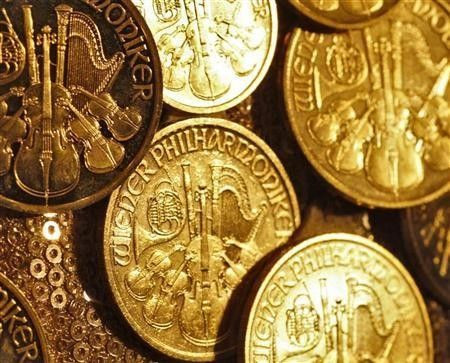Gold Prices Steady, Stronger Euro Offsets ETF Decline

(REUTERS) -- Gold traded broadly steady on Wednesday, as a boost from a modestly stronger euro against the dollar partly offset slow consumer demand and an erosion in holdings of the metal in exchange-traded products.
Holdings of gold in the world's largest ETPs fell by more than 100,000 ounces, following outflows from most of the major funds, marking the biggest one-day decline in three months, reflecting some of the investor shift away from bullion.
Spot gold was quoted up 0.1 percent on the day at $1,650.90 an ounce by 1130 GMT.
The price has fallen by nearly 3 percent so far this month, driven lower by the growing confidence among investors to buy assets that are more exposed to the global growth cycle such as equities or high-yieldingcurrencies.
The risk is that this weak performance will continue and slowly snowball, creating a momentum of its own. Then you might start to see withdrawals from ETFs and shifts into other markets and the price slips lower, Matthew Turner, an analyst at Mitsubishi, said.
What would stop that is a major bullish event on the positive side, he said. A return of the Europe debt crisis is the obvious one but it is a hard one to call in terms of how gold reacts. Definitely bullish - the ECB printing money, but we don't think we are going to see more of that ... another bullish event would be a large central bank purchase, that can't be ruled out, Turner added.
The decline this month in the gold price has prompted one or more central banks to buy as much as four tons of bullion in recent weeks, although more exact figures will likely not be available until the International Monetary Fund releases monthly reserves data in the coming week or two.
DOLLAR LINK
Gold usually maintains an inverse relationship to the U.S. currency, falling as a rising dollar makes it more profitable for non-U.S. bullion owners to sell their holdings.
This correlation has softened somewhat this week to its least negative in three weeks, meaning that gold is less prone to move in the opposite direction to the dollar than it was at the start of the month, when the correlation hit a low of -60 percent.
Also a strike by a majority of jewelers throughout India over the government's plan to raise the import duty on gold has crimped demand this week in the world's largest consumer.
ETP holdings dropped by over 100,000 ounces to 70.715 million ounces, their lowest level this month.
On the macro front, the latest U.S. housing market data added to a string of numbers indicating steady recovery in the world's largest economy, diminishing hopes of further quantitative easing which had helped buoy gold earlier this year.
The dollar .DXY edged down 0.2 percent against a basket of currencies. A cheaper greenback makes dollar-priced commodities, including gold, more attractive to buyers holding other currencies.
Gold has seen some liquidation by funds after the hopes for QE3 (third round of quantitative easing) were dashed, said Peter Fung, head of dealing at Wing Fung Precious Metals in Hong Kong.
Gold found good support at the $1,640 level in the previous session, but in the short-term prices could test $1,620-$1,630 level due to a generally stronger dollar and lack of support from the physical market, Fung added. The dollar index is up about 0.9 percent so far this month.
In other precious metals, palladium largely shrugged off data that showed imports into China, the world's largest consumer of commodities, fell to their lowest since December 2009 in February this year.
Chinese customs data showed imports fell by nearly 40 percent month-on-month to 1,442 kg from 2,381 kgs in January, marking the biggest monthly fall since December 2009.
Spot palladium was quoted up 0.3 percent on the day at $691.22 an ounce, while platinum fell 0.6 percent to $1,638.53 an ounce.
Silver eased 0.1 percent to $32.07 an ounce.
© Copyright Thomson Reuters 2024. All rights reserved.






















